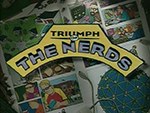 (Editor’s note: Sometimes I’m tasked with writing, or contributing to, academic papers that don’t get published anywhere mainstream. Some of those writings have value to others, either in their content or sources, so I’m going to occasionally copy-paste them here (with sources, whenever possible). However, in no way should any of this be considered legal advice. This first one was my final research paper for Entertainment Law when I was in law school earning my Juris Doctor. It was only ten pages because that course had other writing assignments. )
(Editor’s note: Sometimes I’m tasked with writing, or contributing to, academic papers that don’t get published anywhere mainstream. Some of those writings have value to others, either in their content or sources, so I’m going to occasionally copy-paste them here (with sources, whenever possible). However, in no way should any of this be considered legal advice. This first one was my final research paper for Entertainment Law when I was in law school earning my Juris Doctor. It was only ten pages because that course had other writing assignments. )
Celebrities & The Internet
Celebrities are public persons that spend their life in the spotlight. The publicity that celebrities receive creates many opportunities for them to promote products, develop brand recognition, and make money. The Internet has created many opportunities for celebrities to use their likeness on a global scale. However, the Internet consistently creates new challenges for celebrities to enforce their legal rights. Courts are also constantly forced to reconsider concepts that protect non-celebrities, like free speech and fair use.
Understanding the Internet’s impact on celebrities, and their likeness, requires first defining what constitutes the right to publicity. We must then consider how the legal right of publicity existed before the Internet era. Globalization is also a concern because the Internet is inherently global and not within the jurisdiction of a single court system. The right of publicity is the basis of celebrity legal rights. Copyright affects distribution of material that uses a celebrity’s likeness. Trademark rights also affect commerce that uses a celebrity’s likeness to sell products.
People that are not celebrities have important legal rights of their own that deserve protection. Free speech should not be diminished just so that celebrities can make more money. Fair use is also an important defense that enables public research and academic understanding of topics that might otherwise be restricted because of private interests.
The right of publicity is still a relativity new area of law. Maintaining the proper balance between the rights of celebrities and non-celebrities will always require legal consideration by the courts. Even after addressing the history of publicity, publicity in the Internet era, and current challenges, there will still always be new issues presented to the courts as the Internet evolves and technology improves.
Right of Publicity
The right of publicity is a property right that provides “the right of every person to control the commercial use of his or her identity.” (J. Thomas McCarthy, The Rights of Publicity and Privacy 1 (2d ed. 2000)). That is in contrast to the right to privacy, which is a personal right. One unique legal difference between privacy and publicity is that the right to publicity extends beyond death. “Promotion” is typically distinguished from “exploitation”, which is typically defined as when the promotion occurs at the expense, rather than benefit, of a celebrity.
In 1953, the right of publicity was first recognized by U.S. federal courts in Haelan Laboratories v. Topps Chewing Gum, 202 F.2d 866 (2d Cir. 1953). The dispute involved two chewing gum companies. Haelan Laboratories alleged that Topps Chewing Gum had improperly induced professional baseball players to breach their contracts with Haelan. In these contracts, the baseball players had granted Haelan the exclusive use of their photographs in connection with the sale of baseball cards with gum and had agreed not to grant similar rights to other gum companies. Topps Chewing Gum challenged the validity of the contracts on the grounds that they were merely waivers of right of privacy liability, and that the right of privacy itself was non-transferable. The court disagreed and coined a “right of publicity” that exists apart from the right of privacy. The court’s reasoning was that a person has an alienable right to the publicity value of one’s photo. The court in Haelen did not label the right of publicity a property right, but it clearly distinguished this right from the right of privacy and rights conferred by trademark law.
It wasn’t until 1977, however, in Zacchini v. Scripps-Howard Broadcasting Co., 433 U.S. 562 (1977), that the U.S. Supreme Court acknowledged the right to publicity as separate and distinct from the torts of false light, invasion of privacy, and defamation. The court also held in Zacchini that there was no inherent conflict between the right of publicity and the First Amendment. Zacchini v. Scripps-Howard Broadcasting Co. resulted in an increase in court cases that dealt with the right of publicity.
One noteworthy case post-Zacchini in the Georgia Supreme Court in 1982 required the court to consider whether the estate of Martin Luther King, Jr. could recover for the unauthorized production and sale of statues crafted to resemble Martin Luther King, Jr. Martin Luther King, Jr. Ctr. v. Am. Heritage Prods., Inc., 250 Ga. 135 (1982). That court held that the right of publicity was descendible, extended to celebrities and non-celebrities alike, and protected public and political figures in commercial uses not otherwise protected by the First Amendment.
Another early case post-Zacchini, from 1983, addresses whether the right of publicity has been invaded even when a celebrity’s name or likeness isn’t even mentioned. In Carson v. Here’s Johnny Portable Toilets, 698 F.2d 831 (6th Cir. 1983), the Sixth Circuit Court of Appeals held that “a celebrity’s legal right of publicity is invaded whenever his identity is intentionally appropriated for commercial purposes.” The court also recognized that someone can be identified even when an entire name is not used.
An important case from 1992 actually tests the possibility of whether the right to publicity can restrict the legally-protected right to create legitimate commercial parodies. In White v. Samsung Elec. Am., Inc., 971 F.2d 1395 (9th Cir. 1992), the Ninth Circuit Court of Appeals held that a robot wearing a dress, wig, and gestures evocative of Vanna White were “meant to depict” her likeness and infringed on her right to publicity. That case has been criticized as “as an unreasonable expansion of the identity right on the grounds that the robot at issue merely evoked rather than identified Vanna White and the robot itself could not be connected to Vanna White without including the set and wheel.” (Jonathan S. Jennings, The Right of Publicity and Cyberspace, (2003)).
Before the Internet
Prior to the popularity of the Internet, celebrity rights were mostly about distribution of print, tangible items, audio visual materials, and broadcasts. The economics of these three major mediums meant that legal disputes mostly involved celebrities against businesses. Only businesses, not consumers, had the equipment and resources to create an infringing work that was worth pursuing in court. The costs of distribution meant that most infringing works were small-scale and contained to a particular region. The parties, jurisdiction, and scope of legal disputes were all easily defined.
The popularity of the Internet exploded in the early 1990’s with the creation of the graphical web browser. This new medium meant that anybody – not just businesses – could create color pages of text, photos, audio, and video for almost no cost. It also meant that those pages could be shared with the entire world, all at once, for almost no cost at all. A side effect of that ease of creation and distribution was that people could copy other works on the Internet, including photos and songs, without any consideration as to the legal ownership of that intellectual property.
Even before the Internet, consider the ease of copying that computers themselves make possible. One good example is Pesina v. Midway Manufacturing Co., 948 F. Supp. 40 (N.D. Ill. 1996). The plaintiff in Pesina had modeled his distinct martial arts style for use as computer animation in an arcade game. When the arcade game was later reformatted for in-home versions, Pesina brought suit alleging the violation of his right of publicity. The court granted the defendant’s summary judgment, holding that plaintiff’s likeness lacked commercial value prior to the defendant’s use and that the likeness was not sufficiently recognizable. Although Pesina was unsuccessful, that case raises the possibility of a case in which the use of animation infringes on the right to publicity and constitutes an unlawful use of a person’s identity.
Globalization
Globalization is the single biggest difference between the Internet and traditional forms of communication. Anybody anywhere in the world can create and distribute a work that is seen all over the world. Celebrities in one country are often pursuing claims against defendants in another. Courts are often forced to determine if they even have jurisdiction over the subject-matter and also personal jurisdiction over the parties.
One attempt at resolving the global issues concerning disputes over the right to publicity on the Internet is the Uniform Domain Name Resolution Policy (UDRP). The UDRP is a private dispute resolution procedure for domain name disputes that is administered by the Internet Corporation for Assigned Names and Numbers (ICANN). ICANN is the organization that effectively manages all domain name registrations on the Internet. Implemented in 1999, the UDRP “was implemented to protect trademark holders against the activities of bad faith cybersquatters – those who register domain names speculatively to profit from selling the names to ‘rightful’ trademark owners.” (Jacqueline D. Lipton, Celebrity in Cyberspace: A Personality Rights Paradigm for Domain Name Disputes, 65 Wash. & Lee L. Rev. 1445 (2008)). When Internet domain names are registered, registrants effectively agree by contract to resolve any disputes as to the “rightful ownership” by arbitration. The UDRP eliminates much of the preliminary matters of determining a proper jurisdiction or venue because it is effectively a contract with the domain name registrant and it mandates that a single arbiter handles the dispute.
“A complainant must establish three prima facie elements to warrant transfer or cancellation of a domain name under the UDRP. First, the domain name must be ‘identical or confusingly similar to a trademark in which the complainant has rights.’ Second, the current registrant of the domain name must have no ‘rights or legitimate interests in respect of the domain name.’ Finally, the complainant must show that the domain name was ‘registered and is being used in bad faith.’ An arbitration panel will not transfer or cancel a domain name registration if the complainant fails to show any one of the three elements.” (P. Landon Moreland and Colby B. Springer, Celebrity Domain Names: ICANN Arbitration Pitfalls and Pragmatic Advice, 17 Santa Clara High Tech. L.J. 385 (2000)).
But what if a celebrity does not have a trademark on their own name? That question brings us back to the central question of whether a right to publicity has been violated. The case of Julia Roberts addresses this very situation. In Julia Fiona Roberts v. Russell Boyd, WIPO Case No. D2000-0210 (May 29, 2000), the Respondent, Russell Boyd, registered the domain name juliaroberts.com . He then placed the domain for auction on eBay and received bids in excess of $2,500. Mr. Boyd had also registered more than fifty other celebrity names. “The arbitration panel (the Panel) found Roberts to be ‘a famous motion picture actress’ who had appeared in a number of popular films of moderate to great success. Based on Roberts’ commercial success, the Panel found that ‘registration of [Julia Roberts] as a registered trademark or service mark was not necessary and that the name ‘Julia Roberts’ had sufficient secondary association with Complainant that common law trademark rights [did] exist under United States trademark law. The Panel concluded that ‘[the second level domain name in <juliaroberts.com> was identical to the Complainant’s name.” (P. Landon Moreland and Colby B. Springer, Celebrity Domain Names: ICANN Arbitration Pitfalls and Pragmatic Advice, 17 Santa Clara High Tech. L.J. 385 (2000)).
In contrast, not all celebrity names qualify for protection under the UDRP. Professional names, or “stage names”, create legal problems the UDRP might not solve. In Sumner p/k/a/ Sting v. Michael Urvan, WIPO, D2000-0596 (July 24, 2000), “the Respondent, Urvan, freely admitted that his domain name, <sting.com>, was identical to the stage name of Sumner (Sting). But Urvan contended that Sting had no intellectual property rights under the UDRP as ‘sting’ was a common term and was the subject of twenty United States trademark registrations-none of which belonged to Sumner.” (P. Landon Moreland and Colby B. Springer, Celebrity Domain Names: ICANN Arbitration Pitfalls and Pragmatic Advice, 17 Santa Clara High Tech. L.J. 385 (2000)). The arbitration panel ultimately ruled in favor of Mr. Urvan, holding that “the word ‘sting’ is in common usage in the English language, with a number of meanings … and therefore, that the Complainant’s name STING is not a trademark or service mark within the scope of paragraph 4(a)(i) of the Uniform Policy.”
And what about legitimate fan sites? Are they protected by the UDRP? Recall that to prevail on a UDRP claim, a complainant must address all three elements: (1) identifical, or confusingly similar, to a trademark, (2) the current domain registration must not have ‘rights or legitimate interests in respect of the domain name,’ and (3) the complainant must show that the domain name was ‘registered and is being used in bad faith.’ In The Estate of Tupac Shakur v. R.J. Barranco, eResolutions Case Nos. AF-0348a and AF-0348b (October 28, 2000), “the Panel sought to determine whether the domain names <tupac.net> and <tupac.com> were registered and being used by the Respondent, Barranco, in bad faith. Despite an obvious lack of trademark rights, Barranco was, nonetheless, found to have legitimate rights in the domain names because he operated a fan site with information on Tupac Shakur, offered vanity email addresses and hosted advertisements linking to officially licensed Tupac Shakur merchandise.” (P. Landon Moreland and Colby B. Springer, Celebrity Domain Names: ICANN Arbitration Pitfalls and Pragmatic Advice, 17 Santa Clara High Tech. L.J. 385 (2000)). Similar holdings were reached in Edward Van Halen v. Deborah Morgan, WIPO Case No. D2000-1313 (Dec. 13, 2000), and Jules I. Kendall v. Donald Mayer, re: Skipkendall.com, WIPO Case No. D2000-0868 (OCL 26, 2000).
Copyright & Trademarks
In order to understand how copyright law applies to the right to publicity on the Internet, it is necessary to first have a basic understanding of copyright law itself. The primary purpose for granting copyright is to provide for an “economic incentive to authors to create and disseminate their works for the benefit of the public.” In the United States, copyright is a federal right giving the author of a work the right to exclude others from doing any of five activities: reproduction, adaptation, distribution, performance in public, or display in public. Copyright protects “original” expressions, but does not protect abstract ideas. However, according to the landmark decision in Feist Publications v. Rural Telephone Service, 499 U.S. 340 (1991), even a small amount of skill and labor will satisfy the “originality” requirement. Copyright exists in the United States for every original literary, musical, dramatic, pantomime and choreographic, pictorial, graphic, and sculptural, motion picture and audiovisual, and sound recordings work. Copyright automatically subsists upon the work’s creation even without registration, but the work must be in a “material” and “fixed” form with a permanent character.
In 1996, the World Intellectual Property Organization (WIPO), one of seventeen specialized agencies of the United Nations, passed two treaties in an attempt to harmonize laws between countries. In 1998, the United States enacted the WIPO treaties in the form of the Digital Millennium Copyright Act (DMCA).
The DMCA exists to resolve much of the disputes involving copyright and trademark. The DMCA also places much of the burden on a complainant to show they requested specific infringing material be removed. For example, in O Group, Inc. v. Veoh Networks, Inc., 586 F. Supp. 2d 1132 (N.D. Cal. 2008), the court held that the safe harbor provision of the DMCA protects Internet Service Providers from infringing liability.
Fair Use
Fair use is an affirmative defense to the right to publicity that is essential to protect free speech and legitimate public research on the Internet. The fair use doctrine holds that limited use of copyrighted material may be used without having to first acquire permission from the copyright holder.
A leading case on the defense of fair use is Lenz v. Universal Music Corp., 801 F.3d 1126 (2015), a decision by the Ninth Circuit Court of Appeals. Ms. Lenz posted on YouTube a video of her children dancing to Prince’s song “Let’s Go Crazy”. Universal Music Corporation (Universal) sent Youtube a takedown notice pursuant to the Digital Millennium Copyright Act (DMCA) claiming that Lenz’s video violated their copyright in the song “Let’s Go Crazy”. The court held that that copyright holders must consider fair use in good faith before issuing a takedown notice for content posted on the Internet.
Future Issues
The Internet’s popularity exploded more than twenty years ago. However, courts all over the world still continue to play catch-up with resolving legal disputes over how intellectual property rights should be applied on the Internet. New technologies and uses for the Internet continue to raise new questions and issues. Many of the precedents relied on by the courts address technologies like domain names and web pages. But what about new uses for the Internet like social media? Or ephemeral photo sharing apps like Snapchat? Or augmented reality apps that automatically place fictional items on top of real photographs? These types of uses for the Internet and apps will only lead to new legal disputes involving the right of publicity, copyright, trademarks, and fair use. It will be exciting to see how these types of legal questions are addressed by the courts.
Sources
Books
Keith E. Maskus, Intellectual Property Rights In The Global Economy, (2000).
Thomas McCarthy, The Rights of Publicity and Privacy 1 (2d ed. 2000).
Cases
Carson v. Here’s Johnny Portable Toilets, 698 F.2d 831 (6th Cir. 1983).
Edward Van Halen v. Deborah Morgan, WIPO Case No. D2000-1313 (Dec. 13, 2000).
Feist Publications v. Rural Telephone Service, 499 U.S. 340 (1991).
Haelan Laboratories v. Topps Chewing Gum, 202 F.2d 866 (2d Cir. 1953).
Julia Fiona Roberts v. Russell Boyd, WIPO Case No. D2000-0210 (May 29, 2000).
Jules I. Kendall v. Donald Mayer, re: Skipkendall.com, WIPO Case No. D2000-0868 (OCL 26, 2000).
Lenz v. Universal Music Corp., 801 F.3d 1126 (2015).
Martin Luther King, Jr. Ctr. v. Am. Heritage Prods., Inc., 250 Ga. 135 (1982).
O Group, Inc. v. Veoh Networks, Inc., 586 F. Supp. 2d 1132 (N.D. Cal. 2008).
Pesina v. Midway Manufacturing Co., 948 F. Supp. 40 (N.D. Ill. 1996).
Sumner p/k/a/ Sting v. Michael Urvan, WIPO, D2000-0596 (July 24, 2000).
The Estate of Tupac Shakur v. R.J. Barranco, eResolutions Case Nos. AF-0348a and AF-0348b (October 28, 2000).
White v. Samsung Elec. Am., Inc., 971 F.2d 1395 (9th Cir. 1992).
Zacchini v. Scripps-Howard Broadcasting Co., 433 U.S. 562 (1977).
Law Reviews & Other Periodicals
Jacqueline D. Lipton, Celebrity in Cyberspace: A Personality Rights Paradigm for Domain Name Disputes, 65 Wash. & Lee L. Rev. 1445 (2008).
Jonathan S. Jennings, The Right of Publicity and Cyberspace, (2003).
Navin Katyal, The Unauthorized Dissemination of Celebrity Images on the Internet, 46 Clev. St. L. Rev. 739 (1998).
Landon Moreland and Colby B. Springer, Celebrity Domain Names: ICANN Arbitration Pitfalls and Pragmatic Advice, 17 Santa Clara High Tech. L.J. 385 (2000).
 Triumph of the Nerds: The Personal Computer
Triumph of the Nerds: The Personal Computer
 Prizeo Brings Together Celebrities And Charities To Increase Awareness And Raise Money
Prizeo Brings Together Celebrities And Charities To Increase Awareness And Raise Money
 Venture Deals Explains Modern Venture Capital
Venture Deals Explains Modern Venture Capital
 Five Years of Y Combinator Universe
Five Years of Y Combinator Universe





